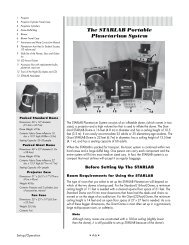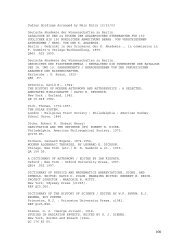K-6 Activities - Dudley Observatory
K-6 Activities - Dudley Observatory
K-6 Activities - Dudley Observatory
Create successful ePaper yourself
Turn your PDF publications into a flip-book with our unique Google optimized e-Paper software.
Materials<br />
• STARLAB Portable Planetarium<br />
• Projector<br />
• Starfield Cylinder<br />
• Constellation Cylinder<br />
• worksheet of circles<br />
K–6 <strong>Activities</strong> • B–66 •<br />
Nightly Position of Constellations,<br />
Activity 5-4<br />
Objective<br />
The student should be able to describe the comparative positions of the circumpolar<br />
constellations in a given 24-hour period.<br />
Background<br />
The constellations, Ursa Major, Ursa Minor, Draco, Cassiopeia, and Cepheus, can<br />
easily be seen circling Polaris in a 24-hour period.<br />
Procedure<br />
• Using standard setup procedure with the Constellation Cylinder, locate the Big<br />
Dipper (Ursa Major) and Polaris. Show students how the Big Dipper appears<br />
to rotate around Polaris. You may do this by turning the projection cylinder one<br />
complete rotation.<br />
• Locate the other major circumpolar constellations and note the motion by turning<br />
the cylinder one complete rotation again.<br />
• Place the Starfield Cylinder on the projector and locate the Big Dipper and<br />
Polaris.<br />
• Give the students the worksheet of circles. Have them draw the position of the<br />
Big Dipper in the appropriate section of Circle #1.<br />
• Move the projection cylinder through 4 hours of the night time sky. You may or<br />
may not wish to identify the particular time. Have the students again draw the<br />
position of the Big Dipper in the appropriate section of Circle #2.<br />
• Continue this same procedure of 4 hour movements and drawing the Big Dipper<br />
in the rest of the sections of each circle. This will show the position of the Big Dipper<br />
through a 24-hour period. You may follow the same procedure for the other<br />
circumpolar constellations.<br />
Note<br />
It should be emphasized that in the real sky all of the positions would not be<br />
seen due to daylight hours.





